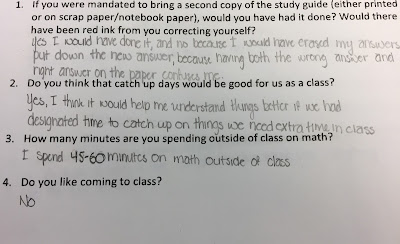Quote of the Day:
“Because our brains are programmed to habituate quickly to our circumstances, we tend to tune out events that happen repeatedly, no matter how positive.” – Ron Friedman
Question of the Day: What happens to the exponent when it is converted to scientific notation in the expression 12 x 10 to the negative second?
Regular Math Objective: Write numbers in scientific notation; multiply and divide numbers in scientific notation find cube roots/square roots of negative exponents and perfect cubes/squares
Regular Math Standards: 8.EE.2 Use square root and cube root symbols to represent solutions to equations of the form x 2 = p and x 3 = p, where p is a positive rational number. Evaluate square roots of small perfect squares and cube roots of small perfect cubes. Know that is irrational.
8.EE.3 Use numbers expressed in the form of a single digit multiplied by an integer power of 10 to estimate very large or very small quantities, and express how many times as much one is than the other. For example, estimate the population of the United States as 3 108 and the population of the world as 7 109 , and determine that the world population is more than 20 times larger.
8.EE.4 Perform operations with numbers expressed in scientific notation, including problems where both decimal and scientific notation are used. Use scientific notation and choose units of appropriate size for measurements of very large or very small quantities (e.g., use millimeters per year for seafloor spreading). Interpret scientific notation that has been generated by technology.
Regular Math Lesson Sequence:


- I collected the study guides. I have never tried this before, but today the study guides were worth 50 points. I put the answers up online for all kids to check their work. What I asked the students to do was try it on their own and check the answers against mine with a different colored pen and write in the corrections. The two examples above were what I was looking for. Some students understood it clearly while others just passed in the study guide we had done from class or tried the online study guide without checking the answers. Overall I think more people studied than they typically would, but for this process to be worth it students needed to check their answers because otherwise they may have just been reenforcing a bad habit.
- I read the directions of the quiz and then gave students one minute to ask each other anything they wanted. Again, I have not tried this before. Some students were silent. Others took advantage. I left out the directions of not looking at your quiz while this was taking place and it was a mistake because I had no control over not telling each other the answer to number one is D or whatever.
- They took the quiz.
- They worked on their TenMarks weekly quiz.
- They did any necessary retakes.
I love what this student did on Problem 1. She is not being apathetic. She wrote that none of the options were scientific notation. She was not nickel grabbing to bring her grade up. And I acknowledged her courage even though her answer was ultimately wrong.
The hardest problems on the quiz were problems four and five (straight out of MCAS and the common core standards) as well as number six. Here's what I saw:
This answer to number five was about as solid as I saw. I liked it because the student used words in combination with the math. Number four is also done correctly here.
The top answer is a misconception I saw a decent amount of. The students were multiplying instead of dividing to show how many times greater something is. The student made things worse by putting a negative seventeen for some reason. The bottom of the two pictures above is a correct answer, but I think it is more of a guess based on the lack of evidence to support the answer.
No problem got more red X's than number six. Students used the exponent 1 more than anything else. They simply do not know how to subtract integers yet. I think there is also a lack of willingness to persevere when it comes to recognizing the meaning behind a negative exponent in a denominator.
Honors Math Objective: Explain why a function exists or does not exit.
Honors Math Standards: A1.F-IF A1 Understand that a function from one set (called the domain) to another set (called the range) assigns to each element of the domain exactly one element of the range. If f is a function and x is an element of its domain, then f(x) denotes the output (range) of f corresponding to the input x. The graph of f is the graph of the equation y = f(x).
Honors Math Lesson Sequence:
- Exponents Jumpstart. I still think that there are students that are failing to see why a negative exponent creates fractions. Since this was a high point of emphasis with regular math and an eighth grade standard I thought it was worth the time to create a chart with the base ten.
- QSSQ
- Review the homework. This was extremely helpful in my opinion for defining what tables and graphs were functions and what were not. We also continued to hammer home the definitions for range, domain and function. Today I introduced discrete and continuous functions as well in pepper.
- Domain, range, and function exit tickets
- Linear functions exploration (got cut off due to time constraints)
Here are some mistakes that were evident on the exit ticket. The students are struggling much more with domain and range than what is and isn't a function. That said, here's a look at what they're doing with the function definitions. The one above is good the one below is good except the one on the right.















































